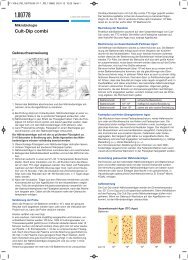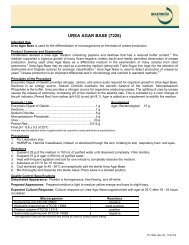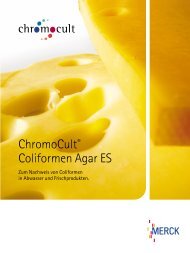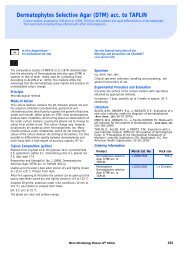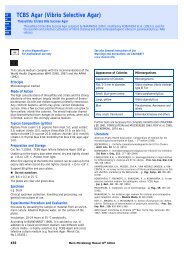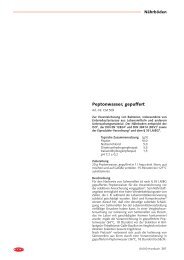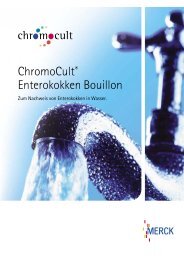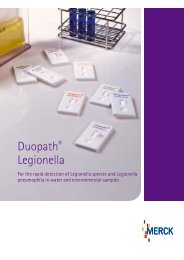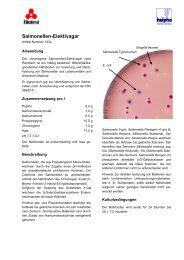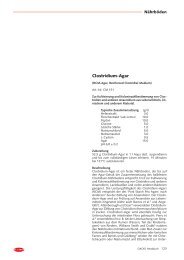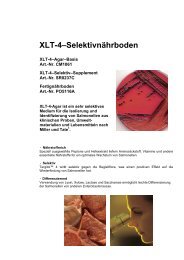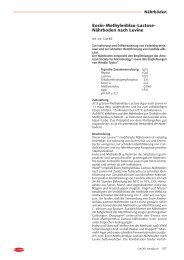Candida Elective Agar acc. To NICKERSON - mibius
Candida Elective Agar acc. To NICKERSON - mibius
Candida Elective Agar acc. To NICKERSON - mibius
You also want an ePaper? Increase the reach of your titles
YUMPU automatically turns print PDFs into web optimized ePapers that Google loves.
<strong>Candida</strong> <strong>Elective</strong> <strong>Agar</strong> <strong>acc</strong>. <strong>To</strong> <strong>NICKERSON</strong><br />
For the isolation and preliminary differentiation of <strong>Candida</strong> and other yeasts <strong>acc</strong>ording to <strong>NICKERSON</strong> (1953).<br />
<strong>Candida</strong> <strong>Elective</strong> <strong>Agar</strong> <strong>acc</strong>. <strong>To</strong> <strong>NICKERSON</strong><br />
in vitro diagnosticum –<br />
For professional use only<br />
See also General Instruction of Use<br />
Warnings and precautions see ChemDAT®<br />
(www.chemdat.info)<br />
Principle<br />
Microbiological method<br />
Mode of Action<br />
This culture medium contains, in addition to a nutrient base<br />
consisting of yeast extract, glycine and glucose, "bismuth sulfite<br />
indicator" which largely suppresses the growth of <strong>acc</strong>ompanying<br />
microorganisms. <strong>Candida</strong> and most other yeasts develop normally,<br />
they reduce bismuth sulite and become brown to black in<br />
colour. BARR and COLLINS (1966) recommended addition of<br />
2mg neomycin sulfate/litre to improve the inhibition of the<br />
<strong>acc</strong>ompanying bacterial flora.<br />
Typical Composition (g/litre)<br />
Yeast extract 1.0; peptone from soymeal 2.0; glycine 10.0;<br />
D(+)glucose 10.0; bismuth sulfite indicator 2.0; agar-agar 15.0.<br />
Preparation and Storage<br />
Usable up to the expiry date when stored dry and tightly closed<br />
at +15 to +25° C. Protect from light.<br />
After first opening of the bottle the content can be used up to the<br />
expiry date when stored dry and tightly closed at +15 to +25°C.<br />
Suspend 40 g/litre, shake well to ensure uniform distribution of<br />
the resulting precipitate, pour plates.<br />
• Do not autoclave!<br />
pH: 6.5 ± 0.2 at 25 °C.<br />
The prepared plates are opalescent and yellowish-white in<br />
colour.<br />
Specimen<br />
e.g. Vaginal Swabs.<br />
Clinical specimen collection, handling and processing, see<br />
general instructions of use.<br />
Experimental Procedure and Evaluation<br />
Take a specimen from the mycelial growth with a platinum loop<br />
or make a pharyngeal or vaginal smear using a cotton wool<br />
swab, spread sample material in the surface of the medium.<br />
Incubation: 4 days at 28°C aerobically and if necessary at 35 °C.<br />
Brown to black, smooth colonies with a pasty appearance are<br />
usually yeasts.<br />
Similarly coloured bacterial colonies or yeast-like fungi do not<br />
often grow on this medium and can be differentiated by<br />
microscopic examination. Dermatophytes and mould appear<br />
seldom on this culture medium and can easily be recognized by<br />
the aerial mycelium.<br />
Further tests should be performed to differentiate the yeasts and<br />
particularly to identify <strong>Candida</strong> albicans. Biochemical methods<br />
for identifying <strong>Candida</strong> species have been described by MARTIN<br />
and SCHNEIDAU (1970).<br />
Literature<br />
BARR, F.S., a. COLLINS, G.F.: A rapid method for the isolation and identification<br />
of <strong>Candida</strong>. - J. Southern Med. Assoc., 59; 694-695 (1966).<br />
<strong>NICKERSON</strong>, W.J.: Reduction of inorganic substances by yeasts. I. Extracellular<br />
reduction of sulfite by species of <strong>Candida</strong>. - J. Infect. Dis., 93; 43-56<br />
(1953).<br />
<strong>NICKERSON</strong>, W.J.: Biology of Pathogenic Fungi. - Chronica Botanica Comp.<br />
Waltham (1947).<br />
MARTIN, M.V., a. SCHNEIDAU, J.D.: A simple and reliable assimilation test<br />
for the identification of <strong>Candida</strong> species. - Am. J. Clin. Path., 53; 875-879<br />
(1970).<br />
Ordering Information<br />
Product Merck Cat. No. Pack size<br />
<strong>Candida</strong> <strong>Elective</strong> <strong>Agar</strong><br />
<strong>acc</strong>. to <strong>NICKERSON</strong><br />
<strong>Candida</strong> <strong>Elective</strong> <strong>Agar</strong><br />
<strong>acc</strong>. to <strong>NICKERSON</strong><br />
1.10456.0500 500 g<br />
1.10456.5000 5 kg<br />
Merckoplate® <strong>Candida</strong><br />
<strong>Elective</strong> <strong>Agar</strong> <strong>acc</strong>. to<br />
<strong>NICKERSON</strong><br />
1.10412.0001 1 x 20 plates<br />
Merck Microbiology Manual 12 th Edition 225
<strong>Candida</strong> <strong>Elective</strong> <strong>Agar</strong> <strong>acc</strong>. <strong>To</strong> <strong>NICKERSON</strong><br />
Quality control<br />
Test strains Growth Recovery rate Colony colour<br />
<strong>Candida</strong> albicans ATCC 10231 good / very good ≥ 70 % brown / black<br />
<strong>Candida</strong> albicans 1021 good / very good brown / black<br />
<strong>Candida</strong> glabrata DSMZ 70614 fair / very good brown<br />
S<strong>acc</strong>haromyces cerevisiae<br />
ATCC 7752<br />
Proteus mirabilis ATCC 29906<br />
Enterobacter cloacae ATCC 13047<br />
Pseudomonas aeruginosa<br />
ATCC 27853<br />
Escherichia coli ATCC 25922<br />
none / poor<br />
none / poor<br />
none / poor<br />
none / poor<br />
none<br />
<strong>Candida</strong> albicans<br />
ATCC 10231<br />
<strong>Candida</strong> glabrata<br />
DSMZ 70614<br />
226 Merck Microbiology Manual 12 th Edition



